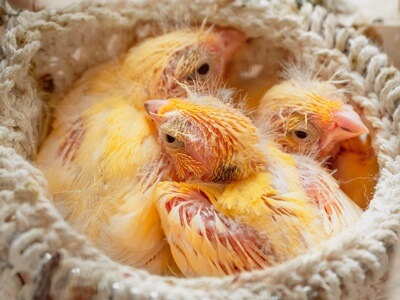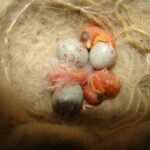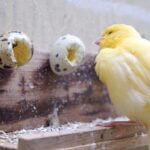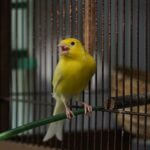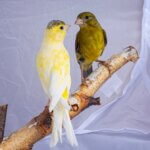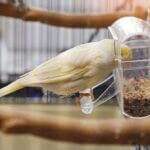Last Updated on: 22nd October 2022, 09:01 pm
Baby canaries hatch without feathers and with their eyes closed. This is completely natural and doesn’t mean anything is wrong with your hatchling’s eyes. After a week (or two, at the most), the chick will open its eyes and begin to show independence.
You only need to worry if the chick’s eyes don’t open after 10-14 years, especially if it opened its eyes but closed them and refused to open them again.
Why Do Canaries Hatch With Their Eyes Closed?
Canaries are an altricial type of avian species, which means that chicks hatch blind and naked, with their eyes firmly closed. As a result, canary chicks rely on their parents for warmth, food, and protection.
Altricial birds hatch underdeveloped and develop traits that make them independent and self-reliant. According to Ecology, environmental factors can also impact the development of altricial birds post-hatching.
Science theorizes that this is caused by the small size of most altricial birds. In particular, the mother bird’s size determines the egg’s maximum size. That, in turn, sets the bar for how much a chick can develop before hatching.
Additionally, there’s a limit to how much energy a canary can expend in creating an egg before it becomes too metabolically expensive.
Other examples of altricial birds include:
- Parrots
- Pelicans
- Songbirds
Birds that hatch with feathers and open eyes are described as ‘precocial’ and leave the nest much earlier than altricial birds. That’s because they’re not reliant on their parents for food and warmth.
When birds are precocial, they’re usually a larger species and must begin fending for themselves quickly.
This is no different from mammals that birth live young and can stand and even run or swim within hours after birth. That’s because the parents must stay active to protect themselves and their young.
Examples of precocial birds include:
- Chickens
- Ducks
- Rhea
Birds and animals with altricial young will nest until their young are ready. This nesting may be due to the need to protect the helpless young, or the helpless young may result from the ability to nest.
At What Age Do Baby Canaries Open Their Eyes?
If your canary hatchlings are provided with ample food, proper temperatures, and a lack of stress, they should begin to open their eyes after one week.
At this point, pin feathers will also begin to sprout. Once a canary hatchling’s eyes open, it’ll become more independent and start to move around.
As well as hatching blind, baby canaries hatch hungry. If you want the hatchlings to develop properly and on schedule, you should provide ample nestling food.
This will ensure that the parent birds can give their chicks all they need. Ideal nestling food includes:
- Boiled eggs
- Soft seed
- Leafy greens
- Fruits
Protein and nutrient-rich greens, such as kale, are important in helping underdeveloped chicks to get strong and grow properly. At 15-17 days, your canary hatchlings should be covered in feathers and starting to leave their nest unless it’s too cold.
This is known as the fledgling stage, but your canary chicks will remain partially dependent upon their parents until 27 days. Their eyes should be fully opened, and their bodies should have all the necessary feathers.
After this point, they can eat all they need independently and will start requiring their own space.
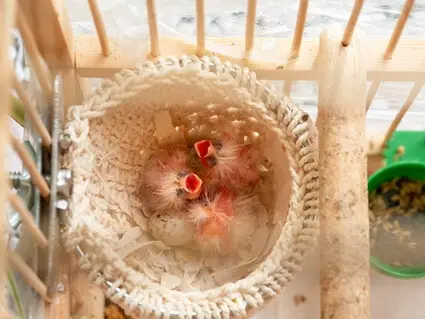
Why Are My Baby Canaries Eyes Still Closed?
Perhaps one canary baby has failed to open its eyes, but its siblings have started to move around. Alternatively, hatchlings that have previously opened their eyes may have closed them again.
You may need veterinary attention due to an ocular deformity in such cases. Less troubling possibilities are treatable infections, such as conjunctivitis.
Failure To Develop In Shell
Birds can be subject to developmental deformities, which happen due to the following:
- Nutritional deficiency in the mother while the embryos were formed.
- The intake of harmful substances during embryo formation.
- Simple genetic deficiencies.
While less common than illnesses and infections, these issues can arise in canaries.
If you notice that one or more of your hatchlings have failed to open their eyes after 10-14 days, they may have such a deformity or developmental issue.
While there may be a deformity, there’s also a chance that the hatchling sustained an infection shortly after hatching, which can be treated.
Post Hatching Infection Or Illness
Hatching can be treacherous for altricial birds due to their underdeveloped and vulnerable nature. Blind and naked canary chicks are more susceptible to being cut or scratched and may get certain infections.
If the sensitive skin around a chick’s eyes sustains damage before its eyes open, it may contract an infection that prevents the eye from opening.
Likewise, after chicks open their eyes, bacterial infections (such as conjunctivitis) are fairly common.
According to Avian Pathology, this may be caused by environmental factors and contact with other infected animals. Conjunctivitis leads to swelling in the sensitive tissue around the eye and ocular discharge, leading to a chick’s eyes being gelled shut.
If allowed to progress further, conjunctivitis may spread to other parts of the eye and even the respiratory system. The symptoms of conjunctivitis in a canary include:
- Inability to or difficulty in opening eyes.
- Ocular and nasal discharge
- Listlessness
- Lack of appetite
- Light sensitivity
- Blindness
What If Canary Chicks Don’t Open Their Eyes?
If your canary chick doesn’t open its eyes or closes them once again after initially opening them, you should check for external debris.
While lots of discharge is a sign of infection, a small amount of healthy discharge crust in a bird’s feathers may prevent it from opening its eyes. If you see some minor discharge that’s pale in color, use a clean cotton bud soaked in warm water to dissolve the mess.
If this is benign, the chick will keep its eye open after you clear it. However, the discharge may be thick, excessive, and dark in color if there’s an infection, and it will also recur.
When caused by an infection, you’ll also see the above signs. At this point, veterinary treatment will be needed to prevent the infection from progressing and spreading.

